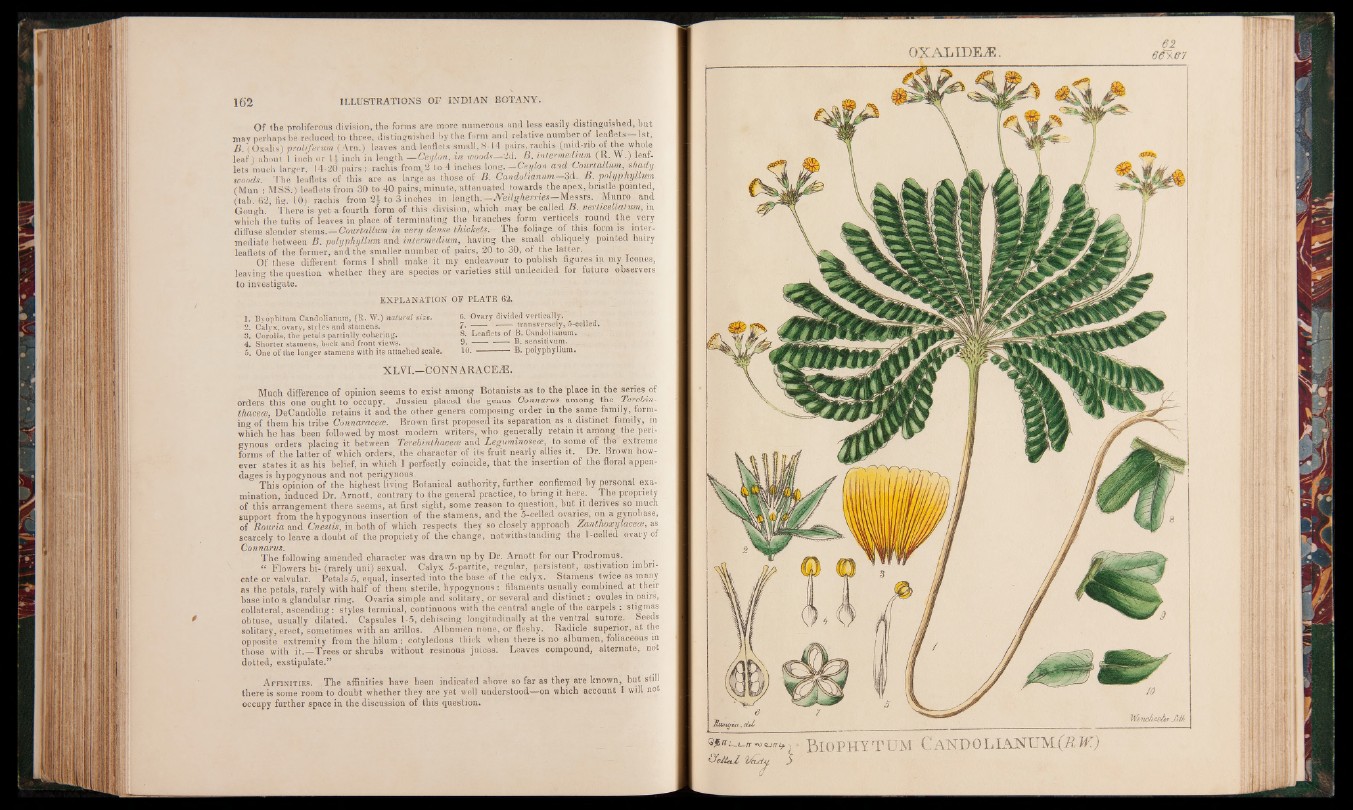
Of the proliferous division, the forms are more numerous and less-easily distinguished, but
may perhaps he reduced to three, distinguished by the form and relative number of leaflets —1st.
JB. (Oxali's) proliferum (Am.) leaves and leaflets small,8-14 pairs.rachis (mid-rib of the whole
leaf) about 1 inch or 14 inch in length -^Ceylon, in woods—2d, B. intermedium, (R. W ) leaflets
much larger, 14-20 pairs : rachis from, 2 to 4 inches long.—Ceylon and Courtallum, shady
woods. The leaflets of this are as large as those of B. Candolianum—3d. B. pnlyphyllum
(Mun : MSS.) leaflets from 30 to 40 pairs, minute, attenuated towards the apex, bristle pointed,
(tab. 62, fig. 10) rachis from 2f to 3 inches in length. — JVeilgherries—Messrs. Munro and
Gough. There is yet a fourth form of this division, which may be called B. verticellatum, in
which the tufts of leaves in place of terminating the branches form verticels round the very
diffuse slender stems.—Courtallum in very dense thickets. The foliage of this form is inter-
mediate between B. polyphyllum and intermedium, having the small obliquely pointed hairy
leaflets of the former, and the smaller number of pairs, 20 to 30, of the latter.
Of these different forms 1 shall make it my endeavour to publish figures in my leones,
leaving the question whether they are species or varieties still undecided for future observers
to investigate.
EXPLANATION OF PLATE 62.
1. Bvophitum Cando'lianuni, (R. W.) natural size.
2. Calyx, ovary, styles and stamens.
3. Corolla, the petals partially cohering.
4. Shorter stamens, back and front views, g
5. One of the longer stamens with its attached scale.
6. Ovary divided vertically.
7. —;— ■ ■ — transversely, 5-celled.
8. Leaflets of B. Gandolianum.
9. ——---------B. sensitivum.
10. ------------ B. polyphyllum.
XLVI.—CONNARACEÆ.
Much difference of opinion seems to exist among Botanists as to the place in the series of
orders this one ought to occupy. Jussieu placed the genus Cannarus among the Terebin-
thacece, DeCandolle retains it and the other genera composing order in the same family, forming
of them his tribe Connaracece. Brown first proposed its separation as a distinct family, in
which he has been followed by most modern writers, who generally retain it among the peri-
gynous orders placing it between TerebinthcLcece and Leguminosets, to some of the extreme
forms of the latter of which orders, the character of its fruit nearly allies it. Dr. Brown however
states it as his belief, in which I perfectly coincide, that the insertion of the floral appendages
is hypogynous and not perigynous.
This opinion of the highest living Botanical authority, further confirmed by personal examination,
induced Dr. Arnott, contrary to the general practice, to bring it here. The propriety
of this arrangement there seems, at first sight, some reason to question, but it derives so much
support from the hypogynous insertion of the stamens, and the 5-celled ovaries, on a gyndbase,
of Rouria and Cnestis, in both of which respects they so closely approach Zanthoxylacece, as
scarcely to leave a doubt of the propriety of the change, notwithstanding the 1-celled ovary of
Connarus.
The following amended character was drawn up by Dr. Arnott for our Prodromus.
“ Flowers bi- (rarely uni) sexual. Calyx 5-partite, regular, persistent, aestivation imbricate
or valvular. Petals 5, equal, inserted into the base of the calyx. Stamens twice as many
as the petals, rarely with half of them sterile, hypogynous : filaments usually combined at their
base into a glandular ring. Ovaria simple and solitary, or several and distinct: ovules in pairs,
collateral, ascending: styles terminal, continuous with the central angle of the carpels : stigmas
obtuse, usually dilated. Capsules 1-5, dehiscing longitudinally at the ventral suture. Seeds
solitary, erect, sometimes with an arillus. Albumen none, or fleshy. Radicle superior, at the
opposite extremity from the hilum : cotyledons thick when there is no albumen, foliaceous in
those with it.—Trees or shrubs without resinous juices. Leaves compound, alternate, not
dotted, exstipulate.”
Affinities. The affinities have been indicated above so far as they are known, hut stil
there is some room to doubt whether they are yet well understood—on which account I will not
occupy further space in the discussion of this question.
0XALIDEÆ. 62
6 6 \6 7
R ioPH T TUM C AND O L IAJSTUM.(iî W )